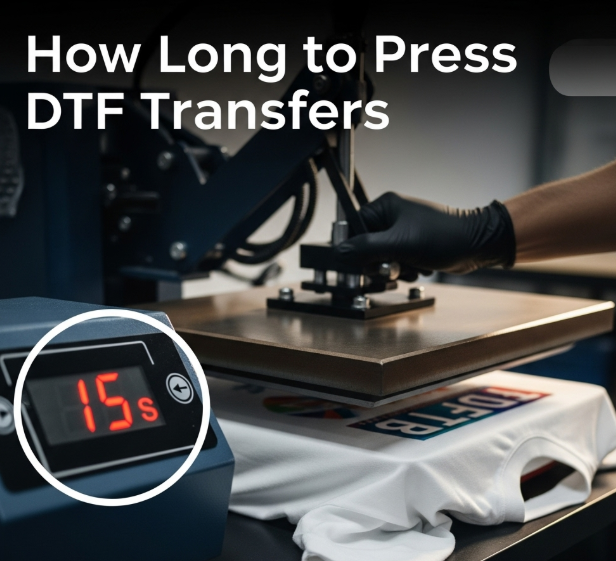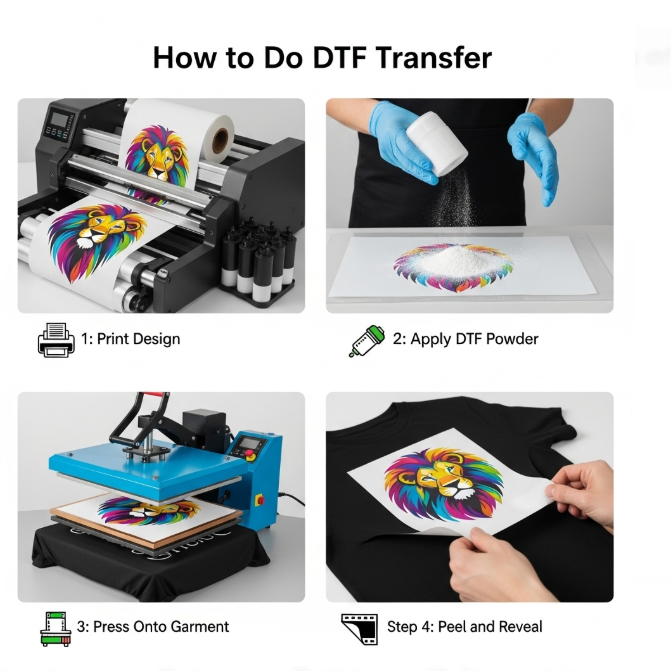
How Long to Press DTF Transfers
The Ultimate Temperature and Time Guide DTF Transfers
Success in custom apparel depends on the perfect heat press settings. Many beginners ask, "How Long to Press DTF Transfers?" The answer is not just a single number. It depends on your fabric, your ink, and your heat press machine. If you press for too short, the design will peel off. If you press for too long, you might scorch the fabric or ruin the adhesive. This guide provides the exact settings you need for professional results. We will cover different materials and professional tips for a perfect bond.
The Standard Rule for How Long to Press DTF Transfers
Most professional DTF transfers follow a general baseline. This works for the majority of cotton and polyester blends.
General Time and Temperature For standard cotton shirts, you should set your heat press to 300°F to 320°F (150°C to 160°C). The ideal time is usually between 10 and 15 seconds. This is the primary answer to "How Long to Press DTF Transfers." You must use medium to firm pressure. This ensures the adhesive melts deeply into the fabric fibers.
The Importance of a Second Press The process does not end after the first press. Once you peel the film, you should perform a "finishing press." This usually lasts 5 to 10 seconds. Use a Teflon sheet or parchment paper during this step. This final heat application improves the wash fastness and softens the feel of the print.
Adjusting Time for Different Fabric Types
Not all fabrics react to heat in the same way. You must adjust your settings based on the material you are using.
100% Cotton Garments Cotton is very durable and can handle higher heat. You can safely press at 320°F for 15 seconds. If the fabric is very thick, like a heavy hoodie, you might need 20 seconds. Cotton absorbs the adhesive well, creating a very strong bond.
Polyester and Synthetic Blends Polyester is sensitive to high temperatures. It can melt or show "scorch marks" if you are not careful. When asking "How Long to Press DTF Transfers" for polyester, the answer is lower and slower. Aim for 270°F to 280°F for about 10 seconds. This prevents the fabric from changing color or texture while still securing the design.
Understanding the Role of Pressure
Time and temperature are only two parts of the triangle. Pressure is the third and equally important factor.
Medium to Firm Pressure DTF requires more pressure than traditional vinyl. You need enough force to push the melted TPU powder into the weave of the shirt. If your pressure is too light, the print will look good but peel after one wash. If you can easily close your heat press with one finger, the pressure is too low. You should feel some resistance when locking the press down.
Consistent Heat Distribution Cheap heat presses often have "cold spots." This means one part of the plate is cooler than the rest. If this happens, it doesn't matter "How Long to Press DTF Transfers" because part of the design won't stick. Always preheat your press for at least 15 minutes before starting. This ensures the entire platen is at the correct temperature.
Cold Peel vs. Hot Peel Settings
The type of film you use changes your workflow significantly. You must check the manufacturer's instructions for your specific film.
Cold Peel Films Most standard DTF films are cold peel. After the initial 15-second press, you must wait for the film to cool down completely. If you peel while it is hot, the ink will lift off the shirt. Patience is key here. Cooling usually takes 30 to 60 seconds depending on the room temperature.
Hot Peel Films Newer "Hot Peel" films allow you to remove the plastic immediately. This speeds up production for busy shops. However, the question of "How Long to Press DTF Transfers" remains the same. You still need that initial 10-15 second bond. Hot peel films are great for high-volume orders but require very steady hands.
Common Problems: Why Your DTF Isn't Sticking
If your transfers are failing, it is usually due to one of three common errors.
-
Moisture in the Fabric: Always "pre-press" your garment for 5 seconds. This removes any moisture and wrinkles. Moisture can create steam, which prevents the adhesive from bonding.
-
Insufficient Heat: If your press is not actually hitting the target temperature, the powder won't melt. Use an infrared thermometer to check your heat platen.
-
Incorrect Timing: If you wonder "How Long to Press DTF Transfers" and choose 5 seconds, it simply isn't enough time. The chemical reaction needs at least 10 seconds to complete.
Advanced Tips for Professional Results
Once you master the basics, you can use these tricks to improve your quality.
Using a Finishing Sheet After the film is removed, use a heavy texture sheet for the second press. A silicone-coated sheet will give the print a matte finish. A Teflon sheet will give it a slightly glossier look. This second press is vital for durability.
The "Pill Test" After your second press, let the shirt cool. Try to pick at the edge of the design with your fingernail. If it lifts even slightly, you need to increase your time or pressure. A perfect DTF transfer should feel like it is part of the fabric itself.
Storage and Handling of Transfers
How you store your transfers before pressing can also affect the timing.
Keep Them Dry DTF transfers absorb moisture from the air. If they are damp, they will require a longer press time to dry out. Store your transfers in sealed bags with silica gel packs. This keeps the adhesive powder fresh and ready for the heat press.
Check the Curing If the powder on your transfer looks grainy, it was not cured properly. You might need to press these for an extra 5 seconds to ensure the glue melts fully. Properly cured transfers should look smooth and slightly shiny on the back.
Conclusion
Knowing "How Long to Press DTF Transfers" is the foundation of a great printing business. Remember the magic numbers: 300°F to 320°F for 10 to 15 seconds. Always adjust for delicate fabrics like polyester. Never skip the pre-press or the finishing press. These small steps ensure that your designs look amazing and last for years. Consistent testing is the best way to find the perfect settings for your specific equipment. With the right time and pressure, your DTF prints will be flawless every time.
Join our growing community online to stay updated with the latest trends and innovations in the printing world. Follow us on
Bringing your custom designs to life with professional quality has never been easier. For high-resolution and durable prints, visit our

